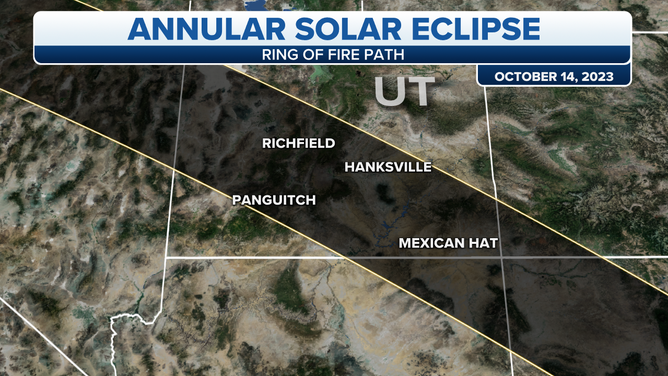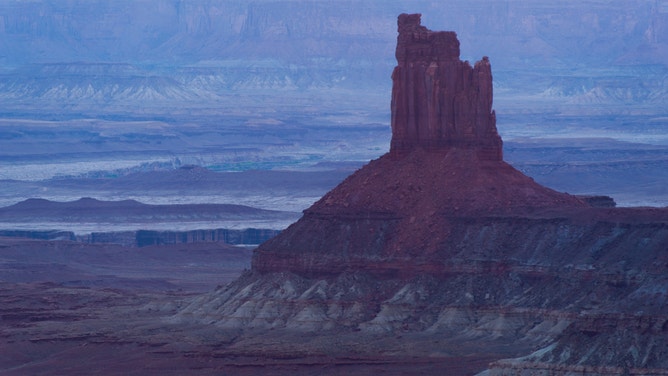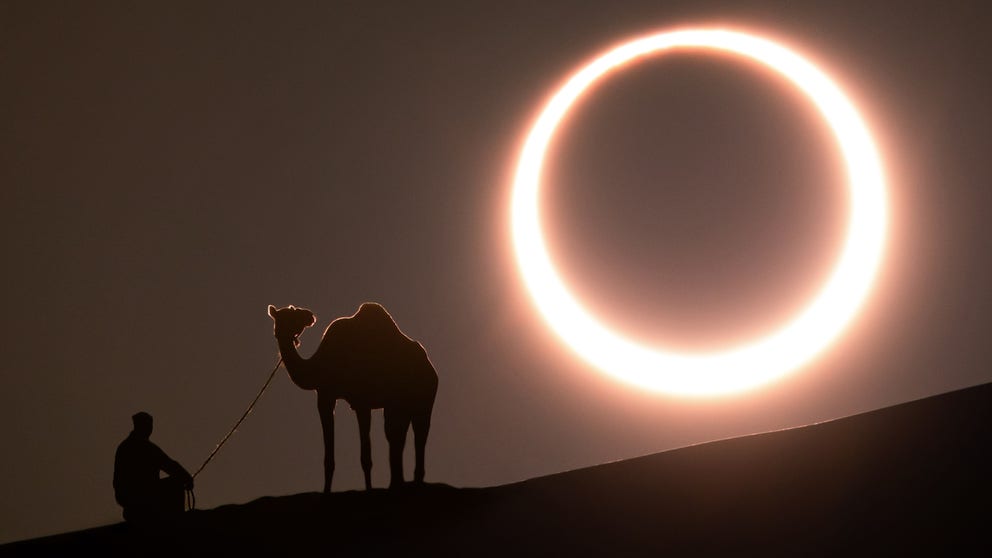Where to see 'Ring of Fire' in Utah during October annular solar eclipse
The "ring of fire" will be visible from parts of Canyonlands National Park and cities including Lake Powell, Richfield, Panguitch, Hanksville and Mexican Hat.
What is a solar eclipse? The different types and how they happen
During a total or annular solar eclipse, the Moon passes in front of the Sun and casts its shadow upon the Earth's surface.
Utah is in the path of the Oct. 14 annular solar eclipse, making the "ring of fire" visible for the Beehive State during the maximum eclipse.
Utah is one of nine states along the path of the maximum eclipse, which stretches from Oregon to Texas. The peak solar eclipse in Utah will be visible from the northwest border with Nevada running through the state to the Four Corners Monument in the Navajo Nation.

The path of the Oct. 14 solar eclipse in Utah.
Here's what you need to know about viewing the 2023 annular solar eclipse in Utah.
What is an annular eclipse?
An annular eclipse is not a total eclipse, as the Moon doesn’t entirely block the Sun’s light – only 90%. An annular eclipse happens when the Moon is at the farthest point in its orbit of Earth. During the maximum eclipse, known as annularity, the light from the sun peaks out around the Moon, creating the "ring of fire" the annular eclipse is known for.
NASA PICKS 5 EXPERIMENTS TO FUND THAT WILL STUDY 2024 TOTAL ECLIPSE IN US
Unlike a total solar eclipse, you will need to wear special eclipse glasses during the entirety of the annular eclipse. Taking the glasses off at any point, even during the maximum eclipse, is unsafe.
Where can I see the 'ring of fire' in Utah?
The Southwest has no shortage of beautiful landscapes to enjoy watching the solar eclipse. Utah is no exception.
The "ring of fire" will be visible from parts of Canyonlands National Park. Zion National Park and Arches National Park are just outside the line of annularity but will still see nearly 80% of the Sun covered.
National Park Service rangers expect big crowds and traffic during the Oct. 14 solar eclipse.
If you want to avoid the crowds drawn to the famous parks, many other options exist to view the maximum eclipse in Utah. Areas including Lake Powell, Richfield, Panguitch, Hanksville and Mexican Hat will be along the path of annularity.
For those planning to camp out at their solar eclipse viewing spot, there is an added benefit to getting there early. While this is a daytime event, Utah is known for its uninhibited sky-gazing conditions with a high concentration of Dark Sky Parks and Communities, many of which are in southern Utah.

Candlestick Tower in Canyonlands National Park, Utah. (Image credit: Neal Herbert/NPS)
(FOX Weather)
When is the solar eclipse in Utah?
In the U.S., the eclipse begins in Oregon at 8:06 a.m. PDT and the partial ends in southeastern Texas at 1:33 p.m. CDT.
WHERE TO SEE 'RING OF FIRE' IN COLORADO DURING OCTOBER ANNULAR ECLIPSE
When the eclipse starts and ends will vary by only a few minutes across Utah, but a partial eclipse will be visible across the state a few minutes after 9 a.m.
The eclipse begins in Richfield at 9:09 a.m., and annularity happens at 10:28 a.m. The ring of fire should be visible for about 5 minutes. At Canyonlands National Park, the "ring of fire" happens at 10:31 a.m. At Lake Powell, annularity is at 10:30 a.m.
The final moments of a partial eclipse will end by noon in Utah.
What will the weather be like in Utah for the annular eclipse?
Viewers in Utah will have a range of temperatures to prepare for depending on where they hope to watch the solar eclipse.

(FOX Weather)
With the Southwest Monsoon season ending in September, conditions will most likely be clear for the upcoming eclipse.
The FOX Forecast Center is tracking some heavier cloud cover over southeastern Utah, which could obscure the view.
According to weather data for Oct. 14 from the National Weather Service in Salt Lake City, Richfield experiences an average high temperature of 69 degrees with an average low of 31 degrees.
If Canyonlands is your pick for viewing the eclipse, expect pleasant weather. High temperatures are, on average, in the 70s, and the normal low temperature is about 40 degrees. There aren't usually a lot of storms with which to contend.
